Anthurium clarinervium, also known as the Velvet Cardboard Anthurium, is a beautiful and unique plant that has stolen the hearts of many indoor plant enthusiasts. This stunning plant originates from southern Mexico and is a part of the Araceae family. What makes this species so different from other Anthuriums is its striking velvet-like leaves that have a cardboard feel to them.
These leaves are heart-shaped and feature veins that create an intricate pattern on them, making it one of the most beautiful plants you could ever own. If you’re looking for a low maintenance indoor plant that’s easy to care for, then the Anthurium clarinervium may not be your first choice.
However, if you’re up for the challenge of providing it with the right growing conditions, then this plant will undoubtedly reward you with its beauty. Care Tips: It’s essential to provide your Anthurium clarinervium with adequate light and humidity levels to ensure optimal growth.
When grown in its natural habitat, this particular species can grow up to three feet tall. However, when grown indoors, it may only reach half this size yet still retain all its beauty and charm.
One thing that sets this species apart from others is how slowly it grows; therefore, it’s an excellent choice for those who want to invest time into nurturing their plants over several years. The Velvet Cardboard Anthurium has become increasingly popular over recent years due to social media platforms like Instagram showcasing its beauty.
It’s no wonder why people have fallen in love with this particular species; if there was ever a ‘plant crush,’ then Anthurium clarinervium would undoubtedly be at the top of anyone’s list! Care Tips: When watering your Velvet Cardboard Anthurium, ensure not to get water on its velvety leaves as they are prone to rotting over time if left damp for too long.
Overall, if you’re looking to add a unique, beautiful plant to your indoor collection, then the Anthurium clarinervium should be at the top of your list! Care Tips: With proper care and maintenance, your Velvet Cardboard Anthurium will thrive indoors for years to come.
Genus Species
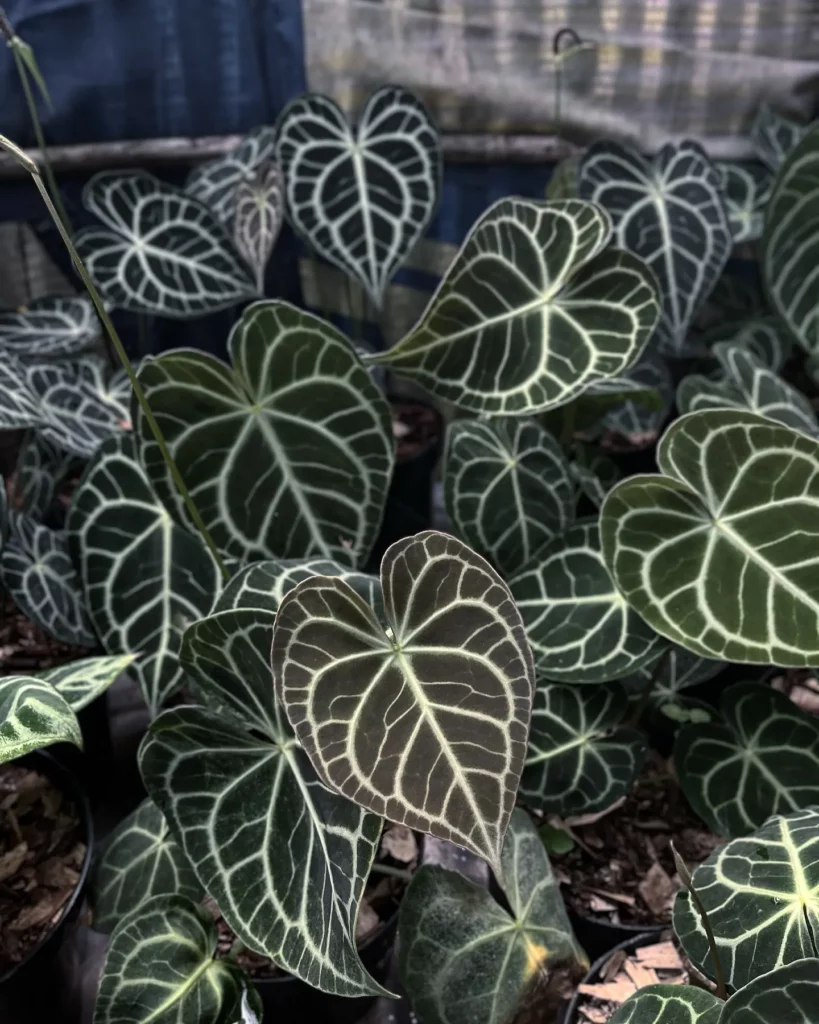
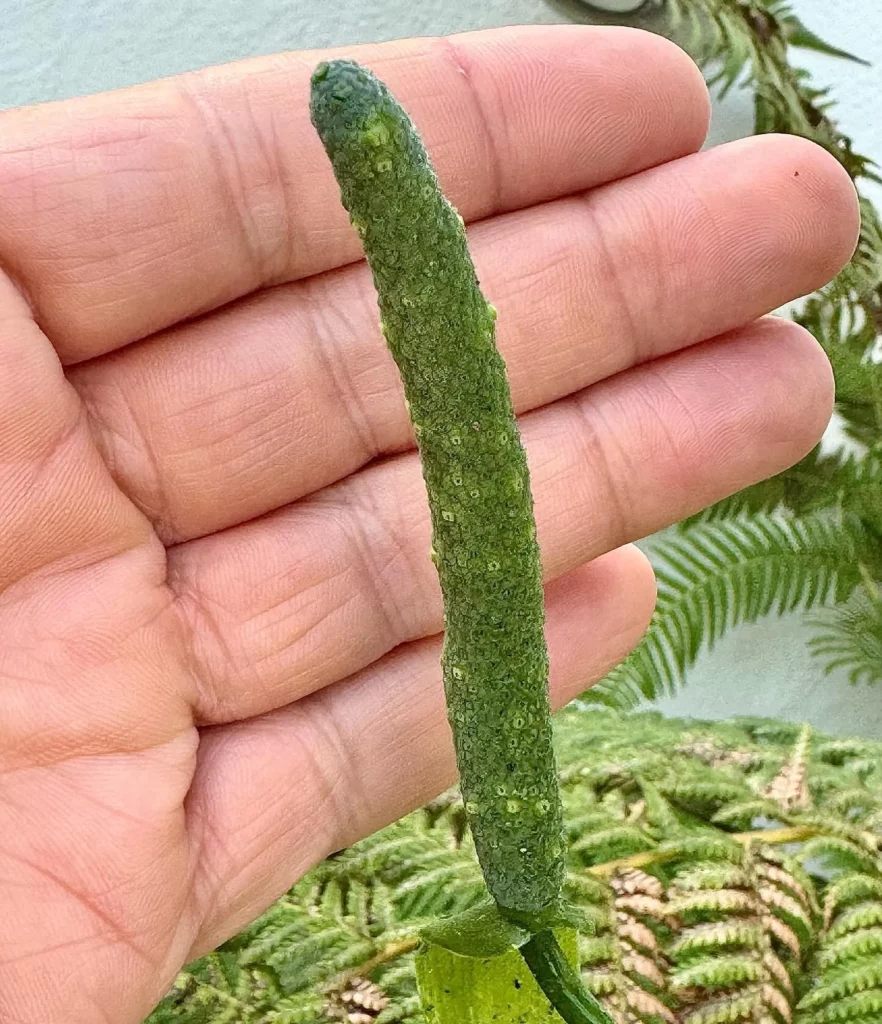
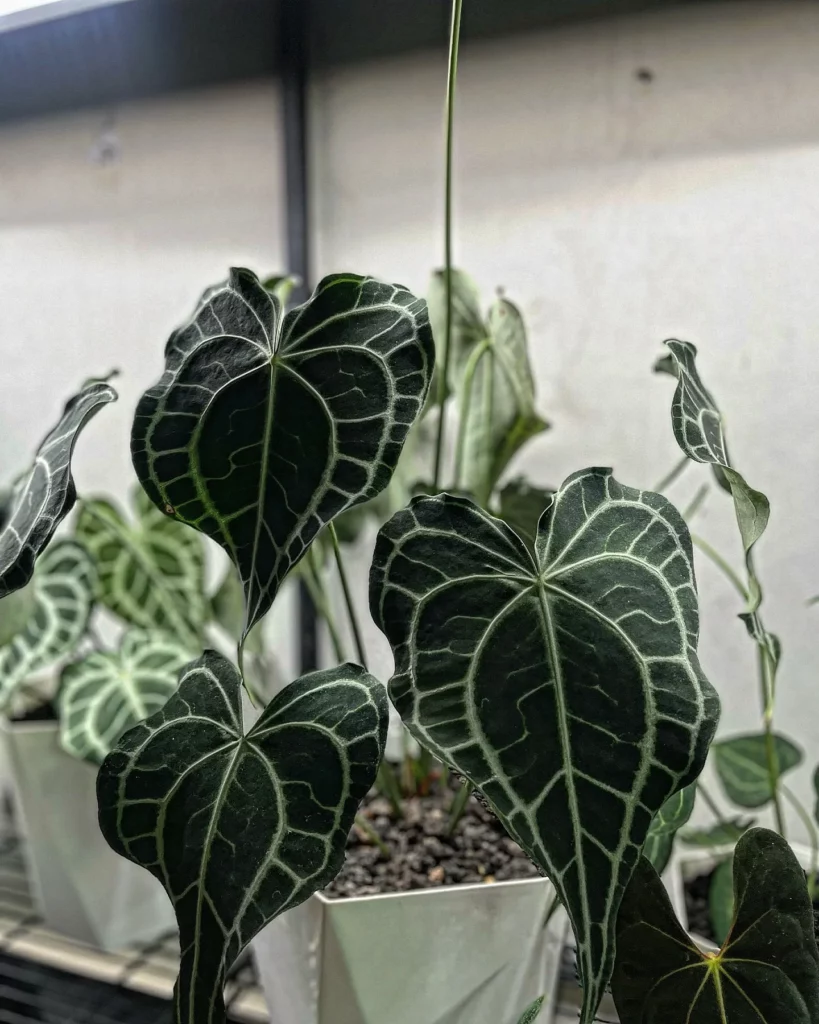
Anthurium clarinervium, also known as the Velvet Cardboard Anthurium, is a plant that has quickly gained popularity in the world of indoor gardening. It is a stunning plant with glossy, green leaves that have prominent white veins running through them. The leaves have a velvety texture and are shaped like hearts, making it an excellent choice for those who love unique and beautiful plants.
The genus Anthurium is a large group of plants that belong to the Araceae family. These plants are native to tropical regions of South America and are commonly used as houseplants due to their stunning foliage and ease of care.
The Anthurium genus includes over 800 species, each with its unique characteristics. The species Anthurium clarinervium is particularly popular among plant enthusiasts because it has distinctive white veins on its leaves that resemble cardboard lines.
This unique characteristic sets it apart from other members of the Anthurium genus and makes it highly sought after by collectors. In terms of care tips for Anthurium clarinervium, it is important to note that this plant requires bright but indirect light to thrive.
Direct sunlight can burn their leaves, so placing them near a window with filtered light is ideal. Additionally, they prefer well-draining soil with good water retention and humidity levels between 60-70%.
Overall, Anthurium clarinervium is an exceptional choice for anyone looking for a unique houseplant with low maintenance requirements. With proper care tips such as avoiding over-fertilization or underwatering the plant should thrive without any major problems.
Anthurium Clarinervium – Velvet Cardboard Anthurium Appearance

Anthurium Clarinervium, also known as Velvet Cardboard Anthurium, is a stunning tropical plant species that can add a touch of elegance and beauty to any indoor space. This plant is a true showstopper, with its large and glossy leaves featuring intricate vein patterns that create an almost psychedelic effect.
The leaves of Anthurium Clarinervium are heart-shaped and can grow up to 12 inches in length. The prominent veins on the dark green surface give the plant its unique velvet-like texture.
When it comes to flowering, the Velvet Cardboard Anthurium produces small flowers in a white to green shade. However, most growers focus on the beautiful foliage rather than the flowers.
One of the best things about Anthurium Clarinervium is that it is relatively easy to care for. This makes it an excellent choice for people who love plants but don’t have much experience with them yet.
Since this plant requires low maintenance and can thrive both in bright indirect light and partial shade, it’s perfect for those who are looking for an adaptable houseplant. Another fantastic feature of Anthurium Clarinervium is its versatility regarding décor style.
How To Grow Anthurium Clarinervium – Velvet Cardboard Anthurium

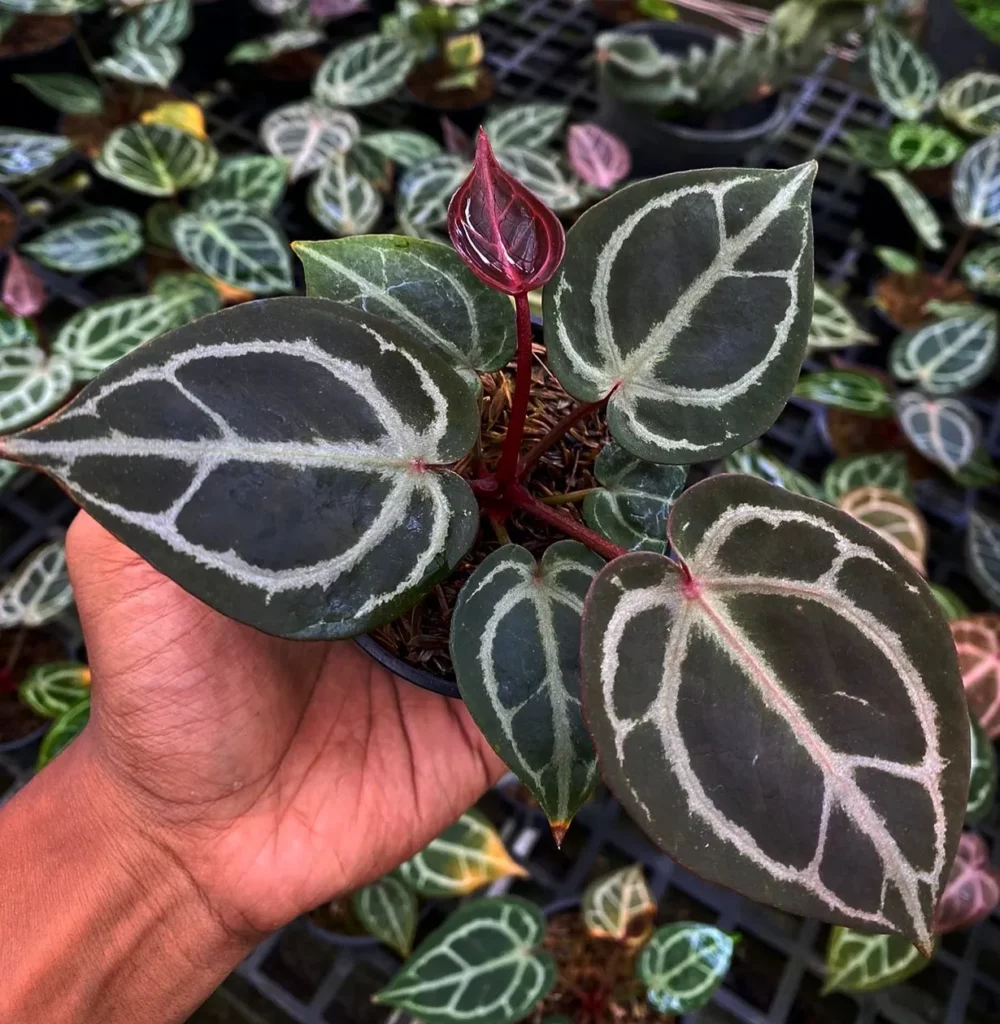
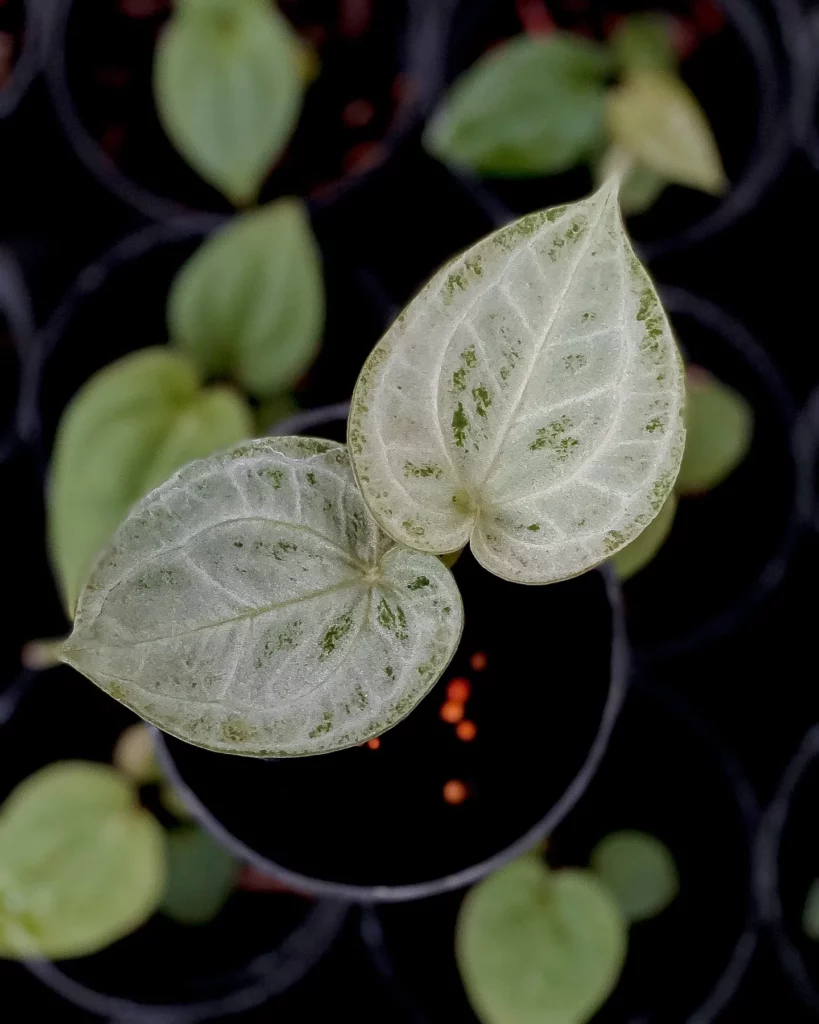
Growing Anthurium clarinervium or Velvet Cardboard Anthurium is an absolute joy. This exotic indoor plant is native to southern Mexico and requires little maintenance, making it a perfect choice for those with a busy lifestyle.
The plant’s standout feature is its heart-shaped leaves that feel like velvet to the touch. The leaves have prominent veins that give them an attractive, almost three-dimensional appearance.
Here are some tips for growing Anthurium clarinervium: Soil: It’s essential to use well-draining soil when planting Velvet Cardboard Anthurium.
Soil that does not drain water properly can cause root rot and ultimately lead to death of the plant. A good soil mix will have a combination of peat moss, perlite, and vermiculite.
Potting: When planting your Velvet Cardboard Anthurium in a pot, make sure the container has drainage holes at the bottom. The size of the pot should be proportional to the size of your plant—nor too big nor too small.
No products found.
Care Tips: Ideally, repotting can be done every two years or when necessary. Lighting: Velvet Cardboard Anthurium prefers bright but indirect sunlight.
Placing it in direct sunlight can cause leaf burn or scorching on foliage which can make your plant look unsightly or not grow at all. Temperature and Humidity: This tropical plant thrives in warm temperatures (70-85°F / 21-29°C) with high humidity levels maintained between 60% – 80%.
If you live in drier climates, it’s essential to use a humidifier or place your plants near one. With proper care, this unique indoor plant will thrive happily under your care for several years while adding beauty and tranquility to any space they occupy!
Anthurium Clarinervium – Velvet Cardboard Anthurium Propagation Tips

One of the most exciting things about owning an Anthurium Clarinervium is getting to watch it grow and propagate over time. Although it can be a bit tricky, propagating an Anthurium Clarinervium is a great way to expand your collection and create beautiful new plants that will provide you with years of enjoyment.
Here are some tips to help you get started: Leaf-cutting propagation: One popular way to propagate an Anthurium Clarinervium is through leaf-cutting propagation.
No products found.
This method involves taking a healthy leaf from your plant and cutting it into sections, which are then placed in a mixture of soil and perlite. Care Tips: Be sure to use sterile tools when making your cuts, as this will help prevent the spread of disease.
Additionally, keep the cuttings in a warm, humid place with indirect light until roots form. Division propagation: Another option for propagating an Anthurium Clarinervium is division propagation.
This method involves separating a healthy plant into smaller sections, each with its own root system intact.
Care Tips: When dividing your plant, make sure each section has at least two leaves and plenty of healthy roots.
Repot each section in its own pot and give them plenty of time to settle in before resuming normal care.
Seed propagation: If you’re feeling adventurous, you can also try propagating your Anthurium Clarinervium from seed.
While this method takes longer than other methods, it can be rewarding to watch your plant grow from scratch!
Care Tips: To start seeds, sow them thinly on top of moist soil mix in shallow tray or pot covered by plastic wrap or clear lid; place them where they’ll get bright filtered light but out of direct sunlight heat; keep soil mix evenly moist without waterlogging; germination may take two weeks or longer depending on temperature etc.
Overall, propagating an Anthurium Clarinervium can be a fun and rewarding experience, as long as you take the time to do it right. With a little patience and some careful attention to detail, you can create beautiful new plants that will bring joy and beauty to your home for years to come.
Anthurium Clarinervium – Velvet Cardboard Anthurium Quick Care Overview

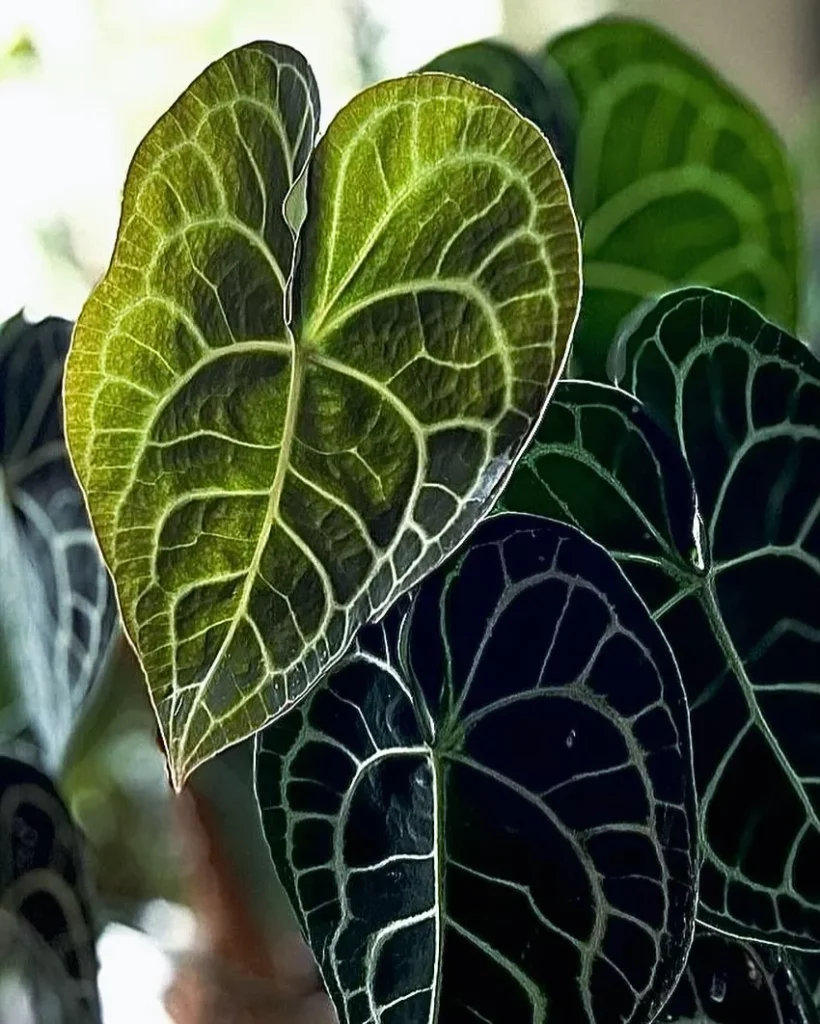
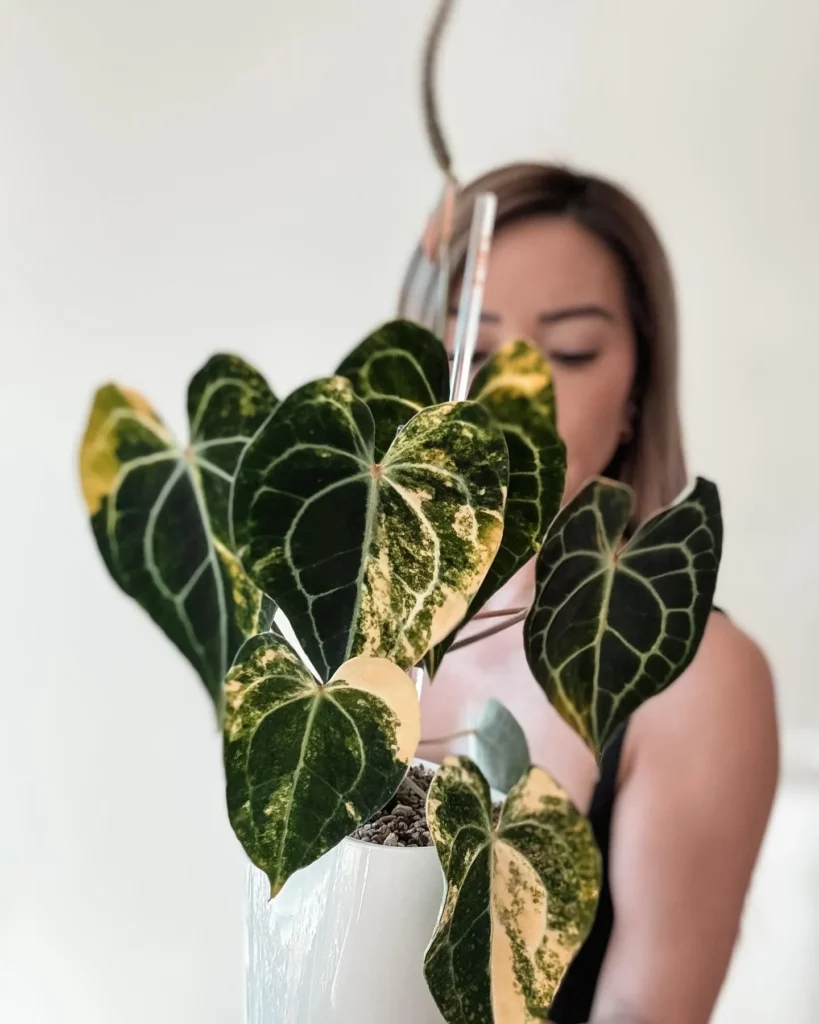
Are you a busy plant parent who wants to add a stunning and low-maintenance Anthurium to your collection?
Look no further than the stunning Anthurium Clarinervium, also known as the Velvet Cardboard Anthurium. These plants are perfect for those who don’t want to spend a lot of time tending to their plants, but still want a showstopper in their home.
The quick care overview of this plant is simple: provide it with the right lighting, soil, and humidity, and it will thrive.
Lighting: As with most houseplants, proper lighting is crucial for the health of your Anthurium Clarinervium.
These plants prefer bright but indirect light, so placing them near a north or east-facing window is ideal. Avoid direct sunlight as this can scorch the leaves.
Remember that these plants are native to tropical forests where they grow under the canopy and receive filtered light.
Soil: The soil you choose for your Anthurium Clarinervium must drain well while also retaining moisture.
A good mix combines peat moss or coco coir with perlite or orchid bark. Avoid using soil mixes that contain too much organic material as they may lead to root rot.
Humidity: These plants love high humidity levels of around 70%. This can be achieved through misting or by placing your Anthurium in a bathroom or kitchen where humidity levels tend to be higher than other areas of the home.
Care Tips: In addition to providing your Anthurium with proper lighting, soil, and humidity levels, there are some additional care tips you should keep in mind. First off, avoid overwatering as this can lead to root rot which can quickly kill your plant.
Water when the top inch of soil feels dry rather than on a set schedule. Additionally, do not fertilize your Anthurium Clarinervium during the winter months when the plant is dormant.
During active growth period, feed your plant with a balanced fertilizer every month during watering times but make sure to dilute it to avoid burning the roots. Keep an eye out for pests such as spider mites and scale insects.
These can quickly take over your plant if not dealt with promptly. Use insecticidal soap or neem oil to get rid of these pesky bugs effectively.
Overall, Anthurium Clarinervium – Velvet Cardboard Anthurium is a beautiful and low-maintenance addition for any indoor environment. With proper care and attention to lighting, soil, humidity, fertilization and pest control, these plants can provide you with years of enjoyment.
Anthurium Clarinervium – Velvet Cardboard Anthurium Light Requirements
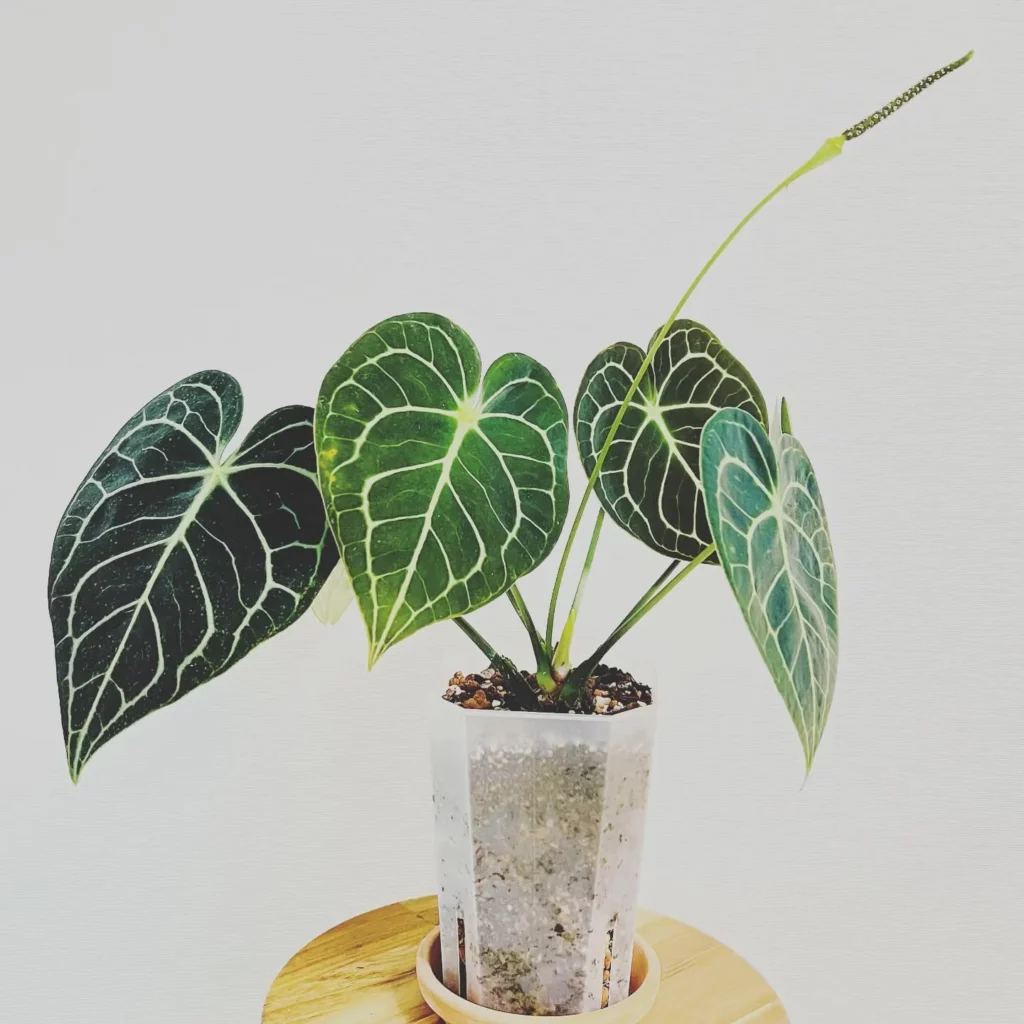
When it comes to Anthurium clarinervium – Velvet Cardboard Anthurium, light requirements are one of the most important factors to consider. These plants are native to the rainforests, which means they prefer bright indirect light.
Direct sunlight can scorch their leaves and cause damage. It’s best to place your Velvet Cardboard Anthurium in a spot where it gets bright, indirect light for most of the day.
This could be near a window that faces east or west, but make sure that the plant isn’t getting direct sunlight during any part of the day. If you have a south-facing window, it’s best to place your plant a bit farther away from the window since this direction gets more intense sun all day.
No products found.
If you don’t have enough natural light in your home, don’t worry – there are ways around this issue. You can use fluorescent lights or LED grow lights as an alternative source of light for your Velvet Cardboard Anthurium if needed.
Make sure that these lights aren’t too close to your plant (about 6-12 inches away) and that they’re on for about 10-12 hours per day. Care Tips: Remember not to overdo it with artificial lighting since these plants need periods of darkness to thrive as well.
It’s essential to note that insufficient lighting can also affect your plant negatively. If you notice slow growth or yellowing leaves even though you’re following all other care guidelines correctly, then lack of proper lighting could be causing these issues.
When caring for your Anthurium clarinervium – Velvet Cardboard Anthurium, ensure that it gets sufficient bright indirect light (not direct sunlight), whether naturally or artificially. Consider using LED grow lights if natural light isn’t enough but ensure not to overexpose them either since they need some dark periods too!
Anthurium Clarinervium – Velvet Cardboard Anthurium Soil Requirements

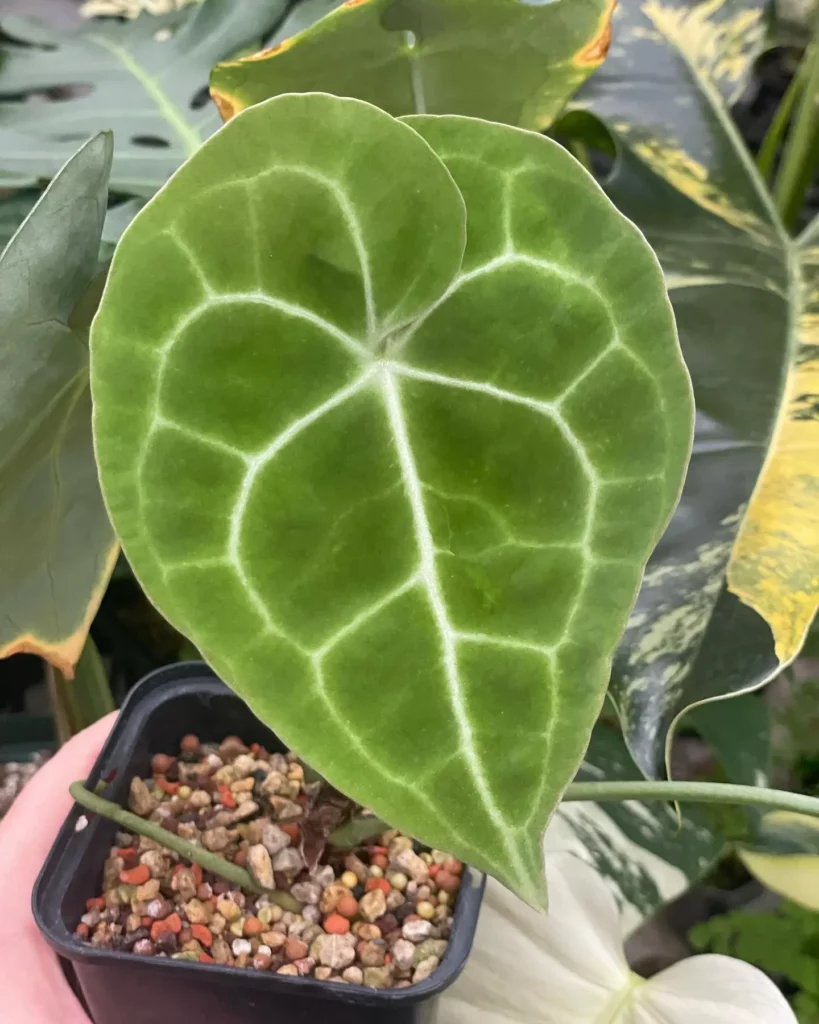
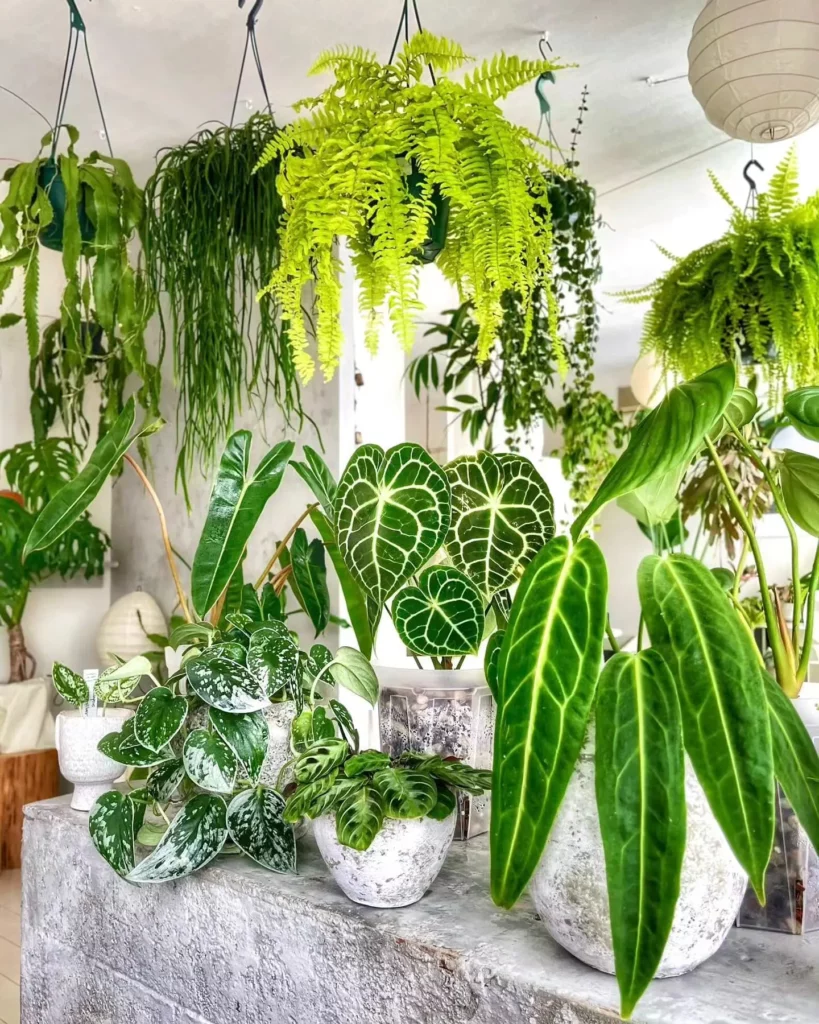
When it comes to the soil requirements of Anthurium Clarinervium – Velvet Cardboard Anthurium, nothing can be left to chance. This plant is known for being extremely finicky when it comes to its growing environment, and soil quality is no exception. These plants need well-draining soil that is rich in organic matter, yet not overly dense or compacted.
Finding the ideal balance between these factors can be tricky, but with a little bit of effort and experimentation, you can create the perfect environment for your Anthurium Clarinervium. One of the most important things to keep in mind when selecting soil for your Anthurium Clarinervium – Velvet Cardboard Anthurium is drainage.
These plants are susceptible to root rot if their roots remain consistently wet or soggy, so it’s essential that you choose a soil mix that allows water to drain freely from the pot. There are several different types of potting mixes available on the market that are specifically formulated for tropical plants like Anthuriums, which typically incorporate a mixture of peat moss, perlite or vermiculite, and sometimes coconut coir.
Another important factor to consider when selecting soil for your Anthurium Clarinervium – Velvet Cardboard Anthurium is nutrient content. These plants require a steady supply of nutrients in order to grow healthy and strong Care Tips include adding slow-release fertilizer pellets into the soil during planting or top-dressing periodically throughout the year with an organic liquid fertilizer.
One thing many people overlook when considering their plant’s needs is pH level. The ideal pH range for anthuriums falls between 5-6 Care Tips include testing your soil regularly with a pH meter or test kit and correcting any imbalances as needed by amending your potting mix with lime (to raise pH) or sulfur (to lower pH).
Anthurium Clarinervium – Velvet Cardboard Anthurium Potting and Repotting
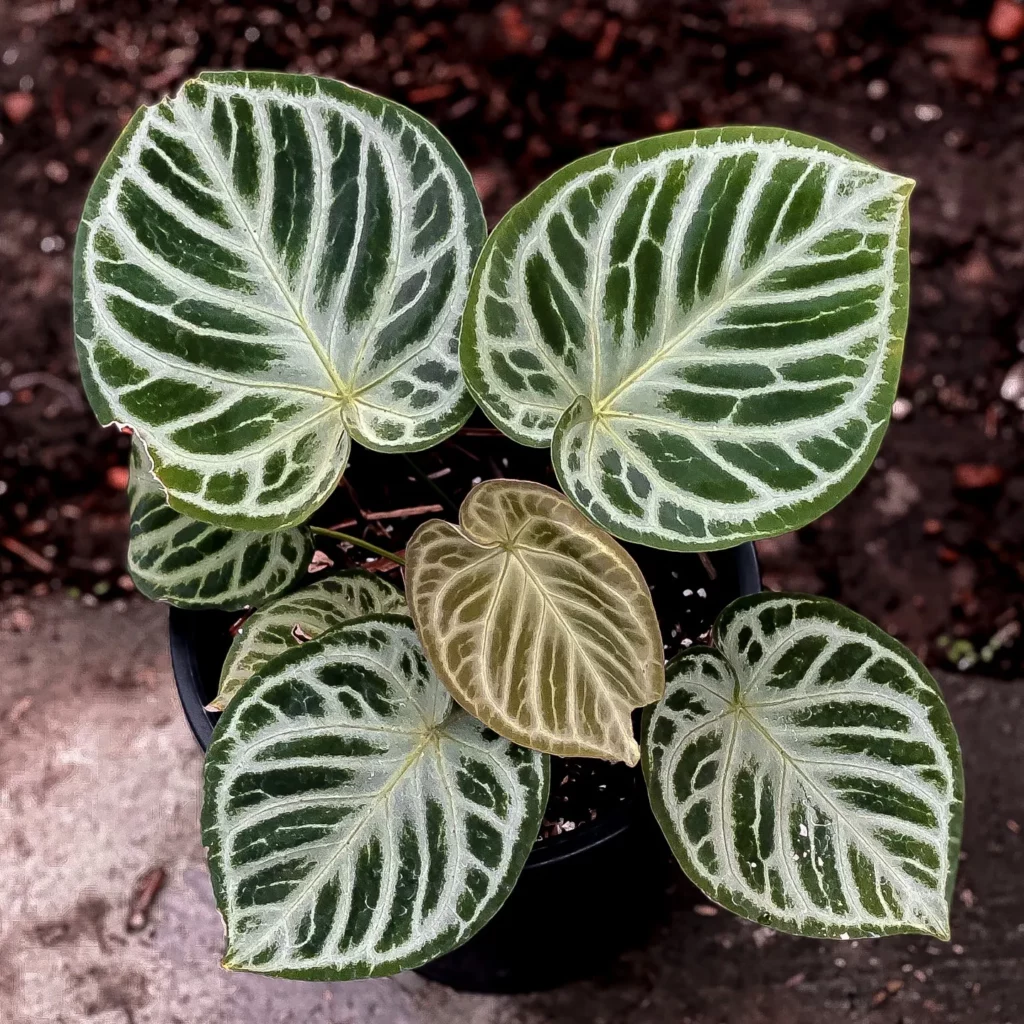
Potting and Repotting Anthurium Clarinervium – Velvet Cardboard Anthurium Anthurium Clarinervium is a unique houseplant that can grow up to 60cm in height. It deserves a special place in your indoor garden because of its beauty and eye-catching appearance.
However, you must provide it with the appropriate pot and soil to ensure that it continues to grow well. In this section, we’ll walk you through some care tips for potting and repotting Anthurium Clarinervium.
No products found.
Pot: When it comes to choosing the appropriate pot for your Anthurium Clarinervium, go for one that is relatively larger than the plant’s root system.
A pot that is too small will hinder growth, while one that is too large will cause overwatering. Clay or terracotta pots are excellent options since they are breathable and help to prevent root rot.
Soil: Anthurium Clarinervium requires well-draining soil with good airflow.
A mixture of peat moss, perlite or sand, and orchid bark works perfectly if mixed well in equal parts. The essential consideration when choosing soil mixtures for your Velvet Cardboard Anthurium is to ensure adequate drainage.
Repotting: It’s advisable to repot your Anthurium Clarinervium every two years during the spring season when it becomes root-bound in its current container.
Repotting helps refresh the soil nutrients as well as providing more space for growth. Steps:
First, ensure you have a new pot about 2-3 inches larger than the current one. Gently remove the plant from its current container.
Remove any dead or diseased roots while ensuring you retain as much of the healthy ones as possible. Fill up the new container with fresh soil mixture halfway through.
Add plant back into its new home. Fill up any remaining space with fresh soil mix and water thoroughly.
Taking care of your Anthurium Clarinervium is a rewarding experience, and providing it with the right pot and soil can lead to luscious growth. Happy Potting!
Anthurium Clarinervium – Velvet Cardboard Anthurium Pruning and Shaping
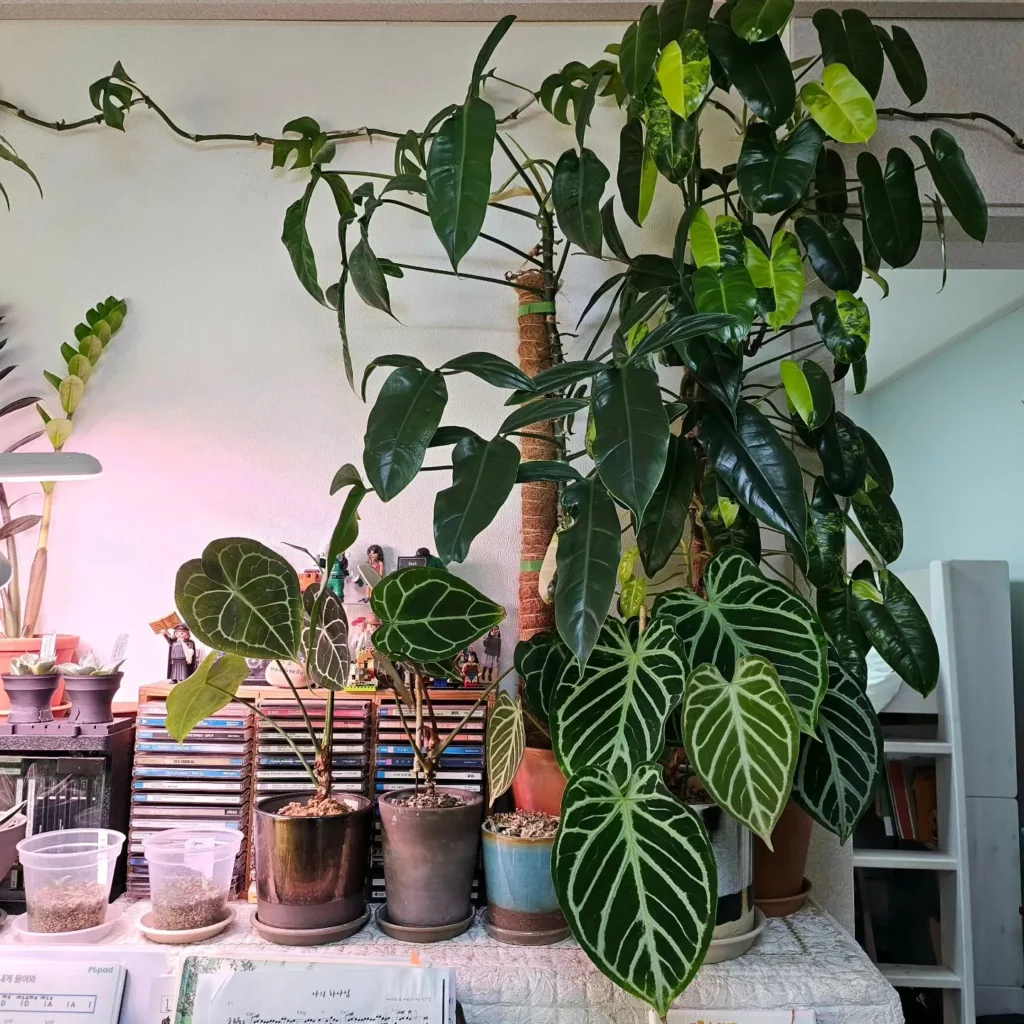
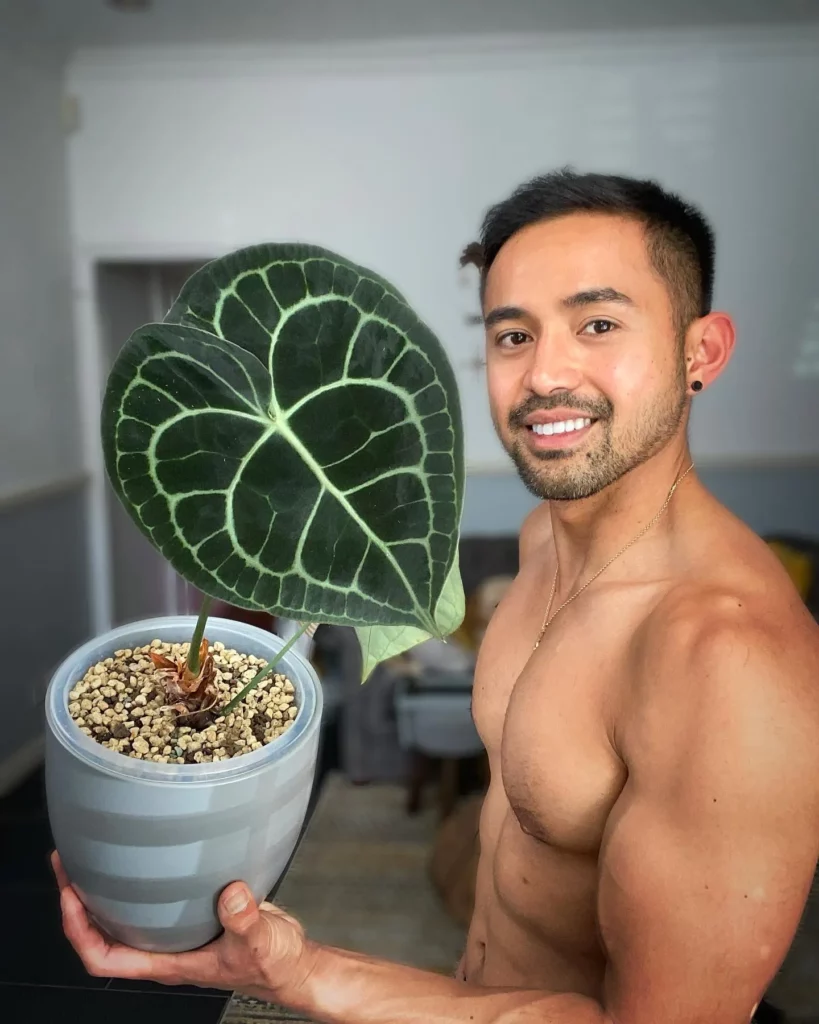
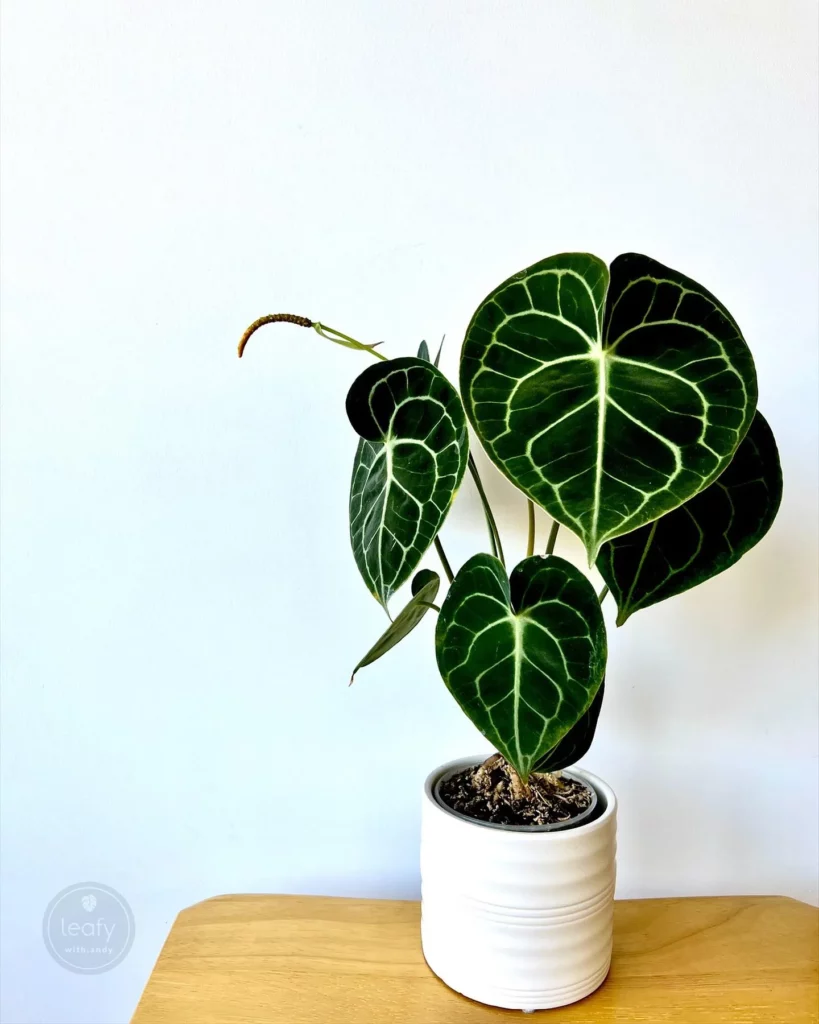
Pruning and shaping are essential tasks in maintaining the gorgeous appearance of your Anthurium clarinervium. Pruning helps to remove dead or diseased foliage and encourages new growth, while shaping gives your plant a more aesthetic look.
Here are some tips for pruning and shaping your Velvet Cardboard Anthurium. When it comes to pruning, always use sharp, clean tools to prevent damaging the healthy parts of the plant.
Start by removing any yellow or brown leaves at their base, using a clean pair of scissors or pruning shears. Cut as close to the stem as possible without cutting into it.
No products found.
This will ensure that no dead tissue remains on the plant, which can attract pests or diseases. Next, identify any damaged or diseased stems that require removal.
If there is any sign of rotting or discoloration on a stem, cut it back to healthy tissue with sharp scissors or clippers. It’s important to make angled cuts when removing sections from the stem as flat cuts tend to leave larger wounds behind that can invite fungal infections in.
When shaping your Anthurium clarinervium, consider its natural growth habit before making any cuts. The Velvet Cardboard Anthurium grows upward from its center and sends out wide leaves from there.
No products found.
To help shape it properly and prevent overgrowth at certain points throughout the year; remove 1/3rd of old leaves every month by cutting them off at their base. If you want symmetrically shaped Velvet Cardboard Anthuriums; prune each branch back by one-third of its length after flowering has ceased in early spring (February/March).
Snip off long shoots with scissors which not only enhances symmetry but also helps improve flowering next season by promoting production of fresh blooms from new branches. Always keep an eye out for suckers – small shoots growing out from beneath existing branches – which can weaken plants over time if left unchecked: Care Tips.
Anthurium Clarinervium – Velvet Cardboard Anthurium Temperature Requirements

One of the things I love most about the Anthurium Clarinervium – Velvet Cardboard Anthurium is its ability to adapt to various temperature conditions.
However, this does not mean that you can just expose it to extreme temperatures without any repercussions. This plant thrives in temperatures ranging from 60°F to 80°F (16°C to 27°C).
Any temperatures below or above this range may cause certain problems such as stunted growth, yellowing leaves, and even death. If you’re living in a tropical region where the temperature is always high, then consider placing your Anthurium Clarinervium – Velvet Cardboard Anthurium in a shaded area where it won’t be exposed to direct sunlight.
No products found.
This will help regulate the temperature and protect it from overheating. On the other hand, if you live in an area with cold weather conditions, then make sure that your plant is far away from windows and doors that are frequently opened.
Cold drafts can easily damage your plant, especially during winter months. When using heating systems inside your home or office during winter months, it’s essential to monitor the temperature regularly.
As much as possible, avoid placing your Anthurium Clarinervium – Velvet Cardboard Anthurium close to heat sources such as radiators or heaters. The dry air produced by these devices can quickly dehydrate your plant and stunt its growth.
Instead of relying on heating systems alone, use humidifiers or misters to provide humidity for your plant. Care Tips:
Use a thermometer to monitor the temperature regularly. – Avoid exposing your plant to extreme temperatures.
Use shading techniques during hot weather conditions. – Keep your plant away from cold drafts during winter months.
Use humidifiers or misters instead of relying on heating systems alone. Maintaining proper temperature conditions for your Anthurium Clarinervium – Velvet Cardboard Anthurium is crucial for its overall growth and well-being.
Make sure to keep it within the recommended temperature range, and avoid exposing it to extreme conditions. By understanding and following these simple care tips, you’ll be able to enjoy a healthy and thriving plant in no time!
Humidity Requirements


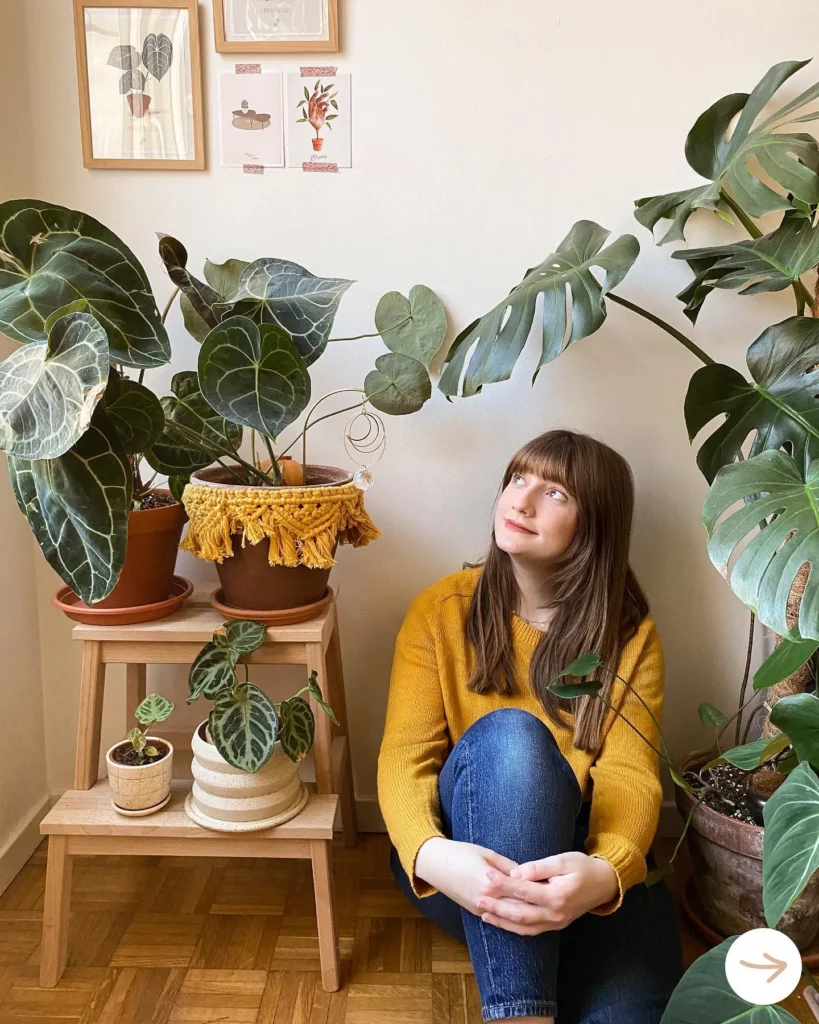
When it comes to Anthurium Clarinervium – Velvet Cardboard Anthurium, humidity is one of the most important factors in their growth. These plants originate from the humid tropical forests of Southern Mexico and require a high level of humidity to thrive.
A lack of humidity can lead to poor growth, stunted leaves, and even death in extreme cases. So how can you provide the right amount of humidity?
No products found.
The easiest way is to place a humidifier in the room where your plant is located. This will keep the air moist and comfortable for both you and your plant.
If you don’t have a humidifier, don’t worry! There are plenty of other ways to increase humidity.
One method is to place a tray filled with water near your plant. You can also mist your plant with water using a spray bottle throughout the day.
This should be done at least once per day, but preferably multiple times for optimal growth. Just make sure not to overdo it as too much water on the leaves can lead to mold or other diseases.
No products found.
Another option is grouping your plants together as they produce their own microclimate which helps raise the overall humidity levels around them naturally. If all else fails then placing a clear plastic bag over your plant will help trap moisture and create a mini greenhouse environment that will make it easier for them to flourish.
Providing adequate humidity for your Anthurium Clarinervium isn’t just some fluffy extra care tip but essential if you want them to grow healthy lush foliage without any issues down the line. By following these tips, you will ensure that your plants receive enough moisture to grow strong and healthy without sacrificing aesthetics or practicality!
Watering Anthurium Clarinervium – Velvet Cardboard Anthurium

Watering is one of the most crucial aspects of Anthurium clarinervium care.
These plants are picky and sensitive, so you need to be extra cautious when it comes to watering them. First things first, never allow your Anthurium clarinervium to sit in water or soil that is too wet.
Overwatering can lead to root rot, which can kill your plant in a matter of days. Instead, you should create a watering schedule that’s consistent with the plant’s requirements.
No products found.
Water your Anthurium clarinervium only when the topsoil has dried out slightly; otherwise, you might end up drowning it in water. If you’re unsure about whether your plant needs water or not, stick your finger into the soil about an inch deep and check if it feels moist or dry.
Care Tips: During winter months and periods of dormancy, reduce watering frequency and amount as appropriate. When watering anthuriums, use lukewarm water that has been left out for at least 24 hours to dissipate any chlorine content in the water supply.
Also try not to get water on its velvety leaves as they are prone to spotting. Moreover, always remember that these plants prefer quality over quantity when it comes to water supply.
No products found.
So if you’re trying too hard by providing excessive amounts of water every day – stop right now! Overwatering is never good for any houseplant; over time this will cause root damage causing stunted or poor growth and even complete death.
Care Tips: In general this species requires less frequent watering than other tropical houseplants because they do best with moderately moist soil conditions rather than constantly wet ones Make sure you avoid both underwatering and overwatering while taking care of this sensitive plant species like velvet cardboard anthuriums.
Be patient when it comes to watering, let the soil guide you on when it is time to water and always err on the side of caution. In doing so, you’ll be rewarded with a healthy, thriving Anthurium clarinervium that will look stunning in your home.
Fertilizing Anthurium Clarinervium – Velvet Cardboard Anthurium
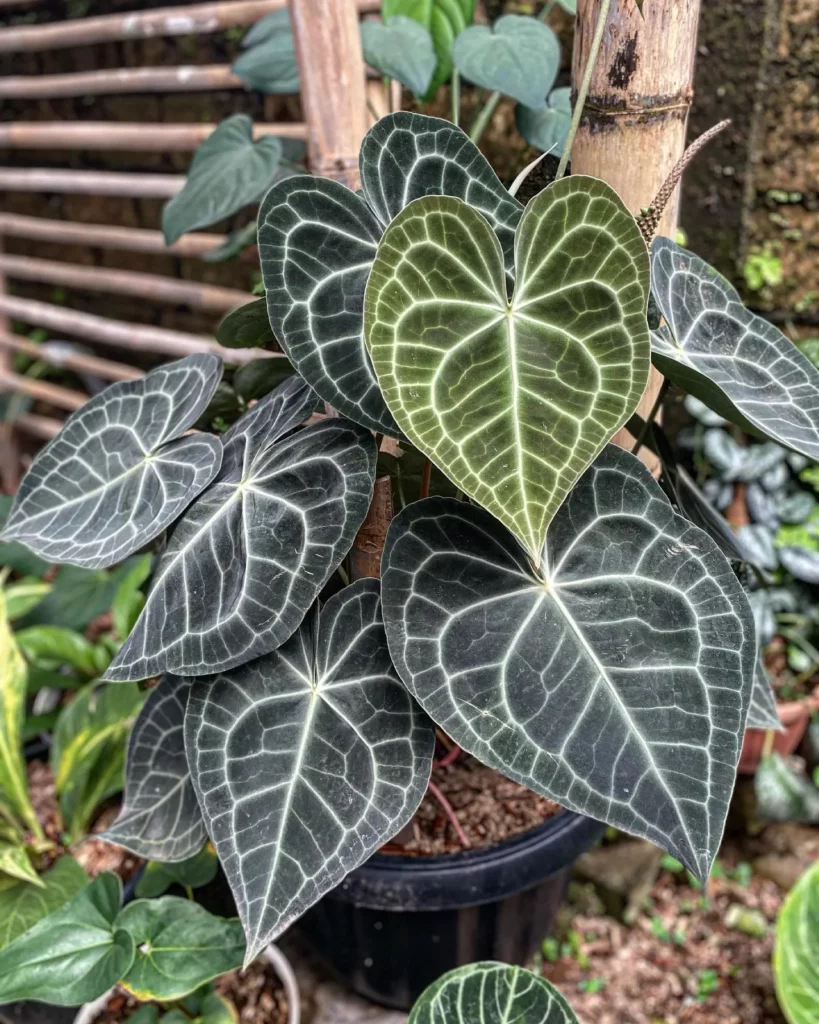
One of the most common mistakes that plant owners make is over-fertilizing their plants.
It’s easy to get carried away with fertilizer, but Anthurium clarinervium doesn’t need a lot of it. In fact, too much fertilizer can harm the plant.
So, when it comes to fertilizing your Velvet Cardboard Anthurium, less is definitely more. A good rule of thumb for fertilizing your Anthurium clarinervium is to do it sparingly and only during the growing season (spring and summer).
You don’t want to fertilize your plant during its dormant period because it won’t be able to absorb the nutrients properly. Use a well-balanced liquid fertilizer with an N-P-K ratio of 1:1:1 or 2:1:2.
The N-P-K ratio represents the percentage by weight of nitrogen (N), phosphorus (P), and potassium (K) in the fertilizer. When you’re ready to fertilize your Velvet Cardboard Anthurium, dilute the fertilizer with water according to the instructions on the package.
Then apply it around the base of the plant, taking care not to get any on its leaves or stem. Too much fertilizer can cause leaf burn or even kill your beloved plant.
Care Tips: – Fertilize sparingly during spring and summer
Use a well-balanced liquid fertilizer with an N-P-K ratio of 1:1:1 or 2:1:2 – Dilute fertilizer according to package instructions before applying
Apply around base of plant, avoiding leaves and stem Another important thing to keep in mind when fertilizing your Anthurium clarinervium is that it prefers organic fertilizers over synthetic ones.
Organic fertilizers contain natural ingredients that are gentler on plants and provide long-lasting nourishment. Synthetic fertilizers, on the other hand, can be too harsh and cause a chemical buildup in the soil over time.
If you’re using an organic fertilizer, you don’t need to worry as much about over-fertilizing because it’s less likely to harm your plant. However, it’s still important to be careful and not apply too much.
Care Tips: Anthurium clarinervium prefers organic fertilizers
Organic fertilizers are gentler on plants and provide long-lasting nourishment – Synthetic fertilizers can be harsh and cause a chemical buildup in soil
Be cautious when fertilizing with either type of fertilizer Don’t forget to water your Anthurium clarinervium before fertilizing it.
Fertilizer can burn the roots if they are dry, so make sure the soil is moist before you apply the fertilizer. Also, avoid fertilizing newly potted plants or those that have just been repotted.
Give them a few weeks to adjust to their new environment before introducing them to any new nutrients. Care Tips:
Water plant before applying fertilizer – Do not fertilize newly potted or recently repotted plants until they have adjusted
Anthurium clarinervium is a beautiful plant that requires only minimal care and attention. Fertilizing your Velvet Cardboard Anthurium correctly is essential for its growth and health.
Pest Control Tips for Anthurium Clarinervium – Velvet Cardboard Anthurium
Anthurium Clarinervium – Velvet Cardboard Anthurium is a popular indoor plant that adds a touch of elegance and beauty to any indoor space. As with any houseplant, pest control is essential to ensure its healthy growth and longevity. Here are some effective pest control tips for Anthurium Clarinervium – Velvet Cardboard Anthurium:
Firstly, prevention is better than cure. Regularly inspect your plants for early signs of infestations such as fragmented leaves, webbing or yellow spots.
If you spot anything unusual, isolate the plant immediately and treat it before it spreads to other plants in your collection. One of the most common pests that attack Anthurium Clarinervium – Velvet Cardboard Anthurium is spider mites.
These tiny pests thrive in warm and dry conditions, so make sure you keep your plant’s humidity levels high by misting it regularly or placing a dish filled with water near it. You can also use neem oil spray or insecticidal soap to get rid of these pesky bugs.
No products found.
Another common pest that often attacks this species of anthurium is mealybugs. These white cotton-like insects appear on the underside of leaves and along stem joints where they suck sap from the plant.
To eliminate mealybugs from your anthurium clarinervium, you can dab them with 70% rubbing alcohol or use insecticidal soap. Aphids are another common pest that poses a threat to your anthurium clarinervium’s health.
These small green insects feed on the sap from new growth causing stunted growth and distorted leaves Care Tips.. To get rid of aphids in your plant, you can spray it with water or use insecticidal soap. Taking care of your anthurium clarinervuim means keeping its environment clean and free from pests while providing adequate light exposure during the day and enough moisture at night.
If you are facing trouble with any of the pests mentioned above, follow these tips and maintain a regular care routine to keep your plant healthy. Remember that a well-cared-for Anthurium Clarinervium – Velvet Cardboard Anthurium can last for years to come, becoming a focal point in your indoor garden.
Anthurium Clarinervium – Velvet Cardboard Anthurium Common Problems
Anthurium clarinervium is a relatively low maintenance plant, but like all plants, it can experience problems.
The most common problems for this species include overwatering, under-watering, and pest infestations. If you’re an Anthurium clarinervium owner who tends to water their plant excessively and frequently, you should know that overwatering can lead to root rot.
Root rot is a fungal infection that attacks the roots of your plant and prevents it from absorbing water and nutrients. To avoid root rot, make sure you allow the soil to dry out completely between watering sessions.
Also, make sure your pot has proper drainage to prevent water from building up at the bottom of the pot. On the other hand, if you tend to water your Anthurium clarinervium irregularly or infrequently, you may notice that its leaves start to wilt or droop.
This usually means that your plant is dehydrated and needs more water. Care Tips: To prevent dehydration in your plant, make sure you’re watering it every 7-10 days or when the top inch of soil feels dry.
Another common problem for Anthurium clarinervium is pest infestations. Pests like spider mites and mealybugs are attracted to this species because of its lush foliage.
These pests can cause damage by feeding on the leaves’ sap and causing discoloration or even death in extreme cases if not addressed early enough. Care Tips: To avoid pests infestations on your velvet cardboard anthuriums make sure to regularly clean their foliage with warm soapy water solution.
But not least among other common problems for Anthurium Clarinervim is brown edges on leaves which are usually caused by low humidity levels around your plant. This issue is easy enough as increasing humidity levels by misting the plant daily or placing a humidifier nearby will solve this issue.
Every Anthurium Clarinervium – Velvet Cardboard Anthurium owner should know how to identify and address these common problems. By following the care tips provided above, you can help keep your plant healthy and thriving for years to come.
Frequently Asked Questions
To care for Anthurium clarinervium, place it in bright, indirect light and avoid direct sunlight. Keep the soil consistently moist but not waterlogged, and ensure good drainage. Maintain a warm and humid environment to promote healthy growth.
Anthurium clarinervium is considered one of the easier velvet Anthuriums to care for. It is known for its resilient nature and can adapt well to indoor environments with proper care and suitable growing conditions.
Yes, Anthurium clarinervium is generally considered a slow grower. It develops new leaves gradually, and patience is required to observe significant growth. However, with proper care and favorable conditions, it can thrive and gradually expand over time.
Anthurium clarinervium benefits from increased humidity, but misting is not the most effective method. Instead, create a humid environment by placing the plant on a tray filled with pebbles and water, or use a humidifier nearby. Avoid misting directly on the leaves, as it can lead to bacterial or fungal issues.
After reading this, check out our other articles on:
Conclusion
The Anthurium clarinervium or Velvet Cardboard Anthurium is an excellent plant for those who love lush greenery and want to add a touch of unique texture to their space. Caring for this plant is not difficult as long as you give it the attention it deserves. In this article, we have covered everything you need to know about growing and caring for your Anthurium clarinervium so that it can look its best.
When it comes to caring for your Velvet Cardboard Anthurium, the most important factor is providing adequate moisture. This plant requires high humidity levels, so be sure to mist it regularly or use a humidifier nearby.
The soil should be kept moist but not waterlogged; overwatering can lead to root rot and other problems. Light is another crucial factor when it comes to growing healthy Anthurium clarinervium plants.
These plants prefer bright but indirect light, so place them near a window with filtered sunlight or under grow lights if necessary. Proper fertilization is also essential in keeping your Velvet Cardboard Anthurium healthy and happy.
Use a balanced fertilizer during the growing season (spring through summer) every two weeks and reduce frequency during winter months when growth slows down. Do not be afraid to prune your plant if necessary.
Pruning can help shape your plant and promote new growth. Remove any yellowed or damaged leaves as soon as they appear using clean pruning shears.
Taking care of an Anthurium clarinervium – Velvet Cardboard Anthurium does not require too much effort or knowledge but it’s still important that you know some basic Care Tips in order to keep this magnificent plant healthy and beautiful all year-round. With proper watering, light exposure, fertilization routine, pruning method and pest control measures you can successfully grow an outstanding houseplant that will add beauty wherever placed!




